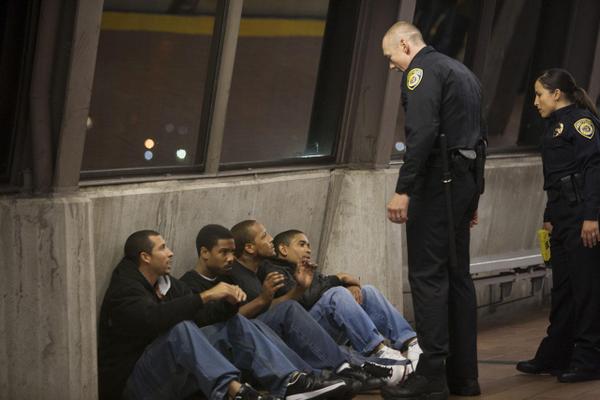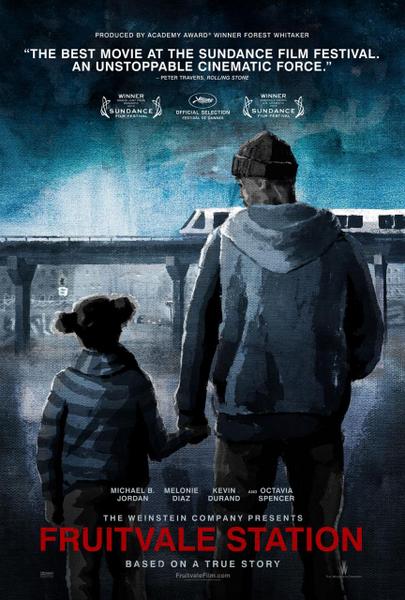Fruitvale Station – A Perennial Story Echoing the Trayvon Martin Killing
One of the films of the moment — the film, if you listen to the pundits — is Fruitvale Station, not just for its depiction of the last day in the lie of a young black man shot to death in the first hours of New Year’s, but for its echoes of the Trayvon Martin killing.
First called Fruitvale for the Oakland BART station where Oscar Grant, 22, was shot by a cop in 2009, the film debut of director Ryan Coogler moves through everyday locations, where a mostly stationary camera watches the action as if it were filming a play. We move through the most ordinary events of a day, making the dramatized story look much like a documentary, or a reality show about what we now see is a national problem. Read Charles Blow in the NY Times on this subject.
The final location is a subway car and a subway station platform where cops empty a train and line black men up, seated against a wall. We hear shots, and one of those men, Oscar Grant, is dead.
When the film was called Fruitvale, Coogler won the top jury prize at Sundance for the realism of his dramatic account of the killing that put cops on trial, starring Michael B. Jordan as the young Grant. Acquired for release by the Weinstein Company, nothing if not shrewd marketers, the name was changed from Fruitvale to Fruitvale Station — just in case its Bay Area origins might lead people to think it was a gay comedy?

Police Lineup in a BART Station
Is it coincidence that the film comes to a national audience at the moment that the Trayvon Martin verdict is a national debate? Not a chance. The film’s marketers know that.
They passed on the opportunity to show Fruitvale Station at the San Francisco International Film Festival (a funder of the movie, more about that later) and took the film to Cannes warm up the press. It didn’t take much to note similarities between what happened in Oakland and the events in Florida and elsewhere.
A look at the facts of the Grant killing reveals details that make it different than the killing of Trayvon Martin. Both are more troubling under scrutiny.
In Oakland, it was the cops who detained Grant, along with a group of black men that include his friends and other revelers on New Year’s. Johannes Mehserle, the cop who shot Grant, said he was reaching for his taser and shot Grant by mistake. Sounds more plausible than Zimmerman saying that Martin reached for his gun. Mehserle was put on trial, and went to prison. He petitioned to become a cop again and failed.

Oscar Grant Left a Young Daughter Behind
Oakland is a dangerous place, no matter what race you are. This is a place where there was a shooting near the Oakland Museum, just as the museum was celebrating its reopening. Not so good for fundraising. The cops have been implicated in making the city more dangerous, if you happen to be young and black. Studies and trials have shown police to be ineffective and incompetent. A new chief was appointed in the spring, so it’s too soon to determine if bad has turned to worse.
Zimmerman was a freelancer, whom cops told to keep back. He pursued martin after being warned by the police, stalked him with loaded gun. If the account that Martin defended himself successfully is correct, Zimmerman claimed self-defense and fired. Indentify, pursue, and if you can’t win, shoot.
You can blame Florida’s stand your ground law for the fact that Zimmerman is walking free today.
To be fair to George Zimmerman (and he’s a man who’s gotten far more than his share of fairness), he didn’t shoot Martin 41 times, as a NYPD Street Crimes Unit did in 1999 when its cops decided that the African street vendor Amadou Diallo, entering his own house in the Bronx, was the serial rapist they were seeking. Those cops eventually ended up walking. You may remember the New Yorker cover of cops shooting at black men at a carnival booth.
We haven’t seen much about that case – certainly not a movie — since all the trials of the cops involved were over.
Much of the credit for keeping the Fruitvale story alive and making it into a film goes to the San Francisco Film Society, which contributed to the film’s production and post-production. The SFFS also put some $200,000 into Beasts of the Southern Wild. Most of that funding came from a donation from one trustee at the SFFS. The funding will continue, says Michele Turnure-Salleo of the SFFS. That’s reassuring for the first-time directors out there, especially those who prove a Bay Area connection.
Maybe there’s another story of a killing of an unarmed black man that Coogler would like to explore. For better or worse, it’s the gift that keeps on giving.
